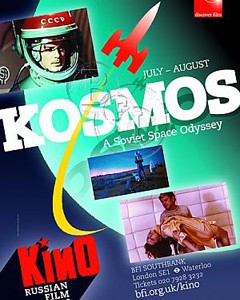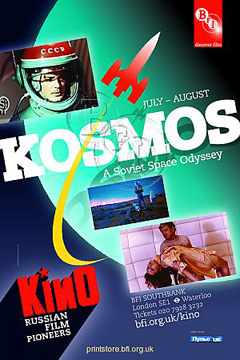 It is a cliché to argue that science fiction is never about the future but always about the time in which it is made. Yet, as with many a cliché, there is often a nugget of truth beneath the grimy accumulation of lazy associations. So it was hard to watch the range of films that the British Film Institute put together as part of its Kosmos season – a celebration of (mostly) Russian (mostly) SF that ran through July & August 2011 – and not see them as marking out the ebbs and flows of the history of Eastern Europe’s and particularly Russia’s last century. In one sense this was all familiar ground to any fan of sf cinema. The screens were full of spaceships and heroes and aliens and there were lots of beautifully realised special effects to admire. Individually some of the films were even familiar either as arthouse classics like Solaris or through cheesy, recut American incarnations like First Spaceship on Venus (The Silent Star). And yet taken together there was something quite distinctive here – a cinema about a people’s hopes and fears for the future that has developed its own conventions and conducts its own conversations with its past and present.
It is a cliché to argue that science fiction is never about the future but always about the time in which it is made. Yet, as with many a cliché, there is often a nugget of truth beneath the grimy accumulation of lazy associations. So it was hard to watch the range of films that the British Film Institute put together as part of its Kosmos season – a celebration of (mostly) Russian (mostly) SF that ran through July & August 2011 – and not see them as marking out the ebbs and flows of the history of Eastern Europe’s and particularly Russia’s last century. In one sense this was all familiar ground to any fan of sf cinema. The screens were full of spaceships and heroes and aliens and there were lots of beautifully realised special effects to admire. Individually some of the films were even familiar either as arthouse classics like Solaris or through cheesy, recut American incarnations like First Spaceship on Venus (The Silent Star). And yet taken together there was something quite distinctive here – a cinema about a people’s hopes and fears for the future that has developed its own conventions and conducts its own conversations with its past and present.
It is always potentially misleading to see history as narrative but it is difficult to look at these films and not see an arc that rises to a peak of confidence and courage at the time of Sputnik, Gagarin’s first orbit and Kruschev’s interlude as leader of the USSR that gave birth to a cinema that was bright, outward-looking and hopeful. And then came the long retreat. The grim decline of the Breshnev decades created its own sf aesthetic – one with a focus that was increasingly internal and that seemed driven to the point of madness as the Soviet experiment collapsed into chaos. And then, in the aftermath – for it turns out that the end of Russian communism wasn’t the end of history – came attempts to make sense of it all, the suffering and the glory.
Here, then, were monuments that marked the birth, brief flowering, long decline and legacy of the Soviet experiment.

Aelita: Queen of Mars (1924) is a curious film. Not a science fiction movie at all (though it features some strikingly designed sequences set on Mars) but rather a rejection of whimsical speculation as a betrayal of the hard work necessary to build a nation in the aftermath of revolution. Daydreaming of other worlds is a threat as great as any posed by the counter-revolutionaries waiting for the opportunity to betray the state or to lead decent folk astray. Aelita begins with the receipt of a message that perplexes scientists of every nation except the dedicated Russian engineer Los and his colleague Spirindinov who, eventually, recognise it as a message from Mars. Los dreams of visiting that distant world and, on Mars, Aelita, daughter of the tyrant Tuskub, watches Los with growing desire. There follows a great deal of back-and-forth involving Los’s wife Natasha and the no-good White, Ehrlich – a thief and scoundrel – and the inept investigations of Kravtsov, a comedy detective. This all, eventually, leads to Los believing that he has killed his wife, disguising himself as the recently fled Spirindinov, building a rocket and flying to Mars. Once there he leads a workers’ revolution but it is (predictably) betrayed by the aristocratic Aelita, who encourages the revolt but then, having disposed of her father, installs herself as the supreme ruler of Mars. But it all works out, Los was merely daydreaming about his Martian exploits, his wife survived his murder attempt and forgives him and he vows to give up his silly space fixation and concentrate on building a better Soviet in the here and now.
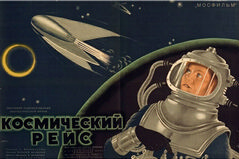
After Aelita there were no Soviet sf films for more than a decade. Then came another oddity, Cosmic Voyage (1935). Based on a novel by one of the father’s of the Russian space programme – Konstantin Tsoilkovsky (who was also a consultant on the film) – it anticipates later American efforts (such as Destination Moon, George Pal’s collaboration with Robert A Heinlein) by applying a relatively high degree of scientific rigour to a story about a journey to the moon. What really marks Cosmic Voyage out as an unusual and, perhaps, a brave film is the central character. While most Soviet sf highlights the collective nature of science and the space effort, Professor Pavel Ivanovich Sedikh is as wily and as determinedly anti-establishment figure as any character in contemporary American sf. The conflict in this movie comes not from the flight to the moon – though there are the obligatory in-flight crises and a cat to be rescued – but from Sedikh’s battle with the bureaucrats seeking to stop his flight. Given that the film was made in a nation of the verge of the Great Purge (1937-8) in which hundreds of thousands of “enemies of the state” were eliminated, there is something a little subversive about Cosmic Voyage, even if the spaceship is called Joseph Stalin.
The later years of Stalin’s rule were not fertile ground for science fiction. There was a Russian adaptation of Jules Verne’s Mysterious Island in 1941 but beyond that, there was almost nothing. There were perhaps just three major pieces of Soviet science fiction cinema made between the revolution and the death of Stalin in 1953. One can guess why the Stalinist regime didn’t like the idea of people imagining that a better world might be possible – after all, actually existing communism was building the perfect society on Russian soil. To imply that the future might be different – or better – implied that the existing regime was somehow flawed. And, in any case, who would be crazy enough to speculate about the future in a country where the past kept changing.
It took the coincidence of Kruschev’s less repressive reign (1956-1964) with the launch of Sputnik 1 and Yuri Gagarin’s great adventure aboard Vostok 1 to create a sudden, colourful explosion of science fiction in the Soviet Union.
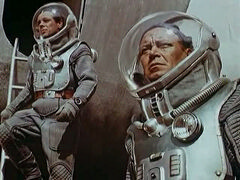
The Kosmos season included some of the wonderful films of Pavel Klushantev – his beautifully realised documentary/speculative meditation Road to the Stars (1958), his purely sf feature Planet of Storms (1962) and a number of his short films as well as the interesting, but politically one-dimensional and chronologically suspect, Danish documentary about his work: The Star Dreamer (2002). Klushantev’s films are marked out by spectacular models and excellent special effects but also a seriousness of intent and their emphasis on scientific rigour. For all the visual flash and wonder, there’s always a thread of philosophical musing not far below the surface. So, in Planet of Storms, with its improbable flight to Venus, alien vegetable monsters and a momentary glimpse of mysterious, beautiful, alien women, the action is interspersed with digressions in which the cosmonauts pause to consider the implications of biological theory and the inevitable colonisation of space by races who value peace and rationalism.
In The Star Dreamer Klushantev is portrayed as a victim of the Soviet regime – their refusal to back an earlier feature film, Moonstone, the Soviet culture secretary’s criticisms of Planet of Storms (for having the female cosmonaut cry in a moment of crisis) and the eventual removal of his short documentary Moon from Soviet theatres after the Apollo landings are all cited as evidence of the difficulties he faced and which eventually led to his sacking by the studio. But the actual history of things appears more complex. Moonstone may have been a work of genius (we’ll never know) but Klushantev was hardly the only filmmaker to have a cherished project rejected by a studio, whatever the political system. The makers of The Star Dreamer suggest that Moonstone was rejected because it featured a plot in which American and Soviet explorers work together after an accident on the Moon – stating that a film that featured cooperation between the two competing nations was out of the question. But, as we shall see, Russians working as part of a multi-national crews – often alongside Americans – was a recurring themes in the Soviet sf of this era. The idea that Moonstone was blocked because of this one point seems unlikely.

The fact that Planet of Storms was made after the rejection of Moonstone doesn’t suggest that Klushantev had been placed on anyone’s blacklist. It may well be true that Moon, made in 1965, wasn’t shown in Soviet cinemas after Armstrong landed at Tranquility Base in 1969 but it was already four years old and, given that it posits Russian victory in the race to the moon, some of its credibility as documentary would have been badly damaged. And much of the scientific speculation in Moon (about the surface of the satellite or the means by which the landings would be made) was rendered obsolete by the Apollo mission. Audiences had seen real men bob around on the surface of the Moon, it’s hardly surprising that Klushantev’s speculation about how such events might look would no longer seem relevant. Nor was Moon Klushantev’s last film – another documentary, Mars, followed in 1968 (The Star Dreamer doesn’t mention this at all) while the letter sacking him from the studio (for the poor quality of his work – which does seem terribly harsh) is clearly dated 1972. None of this suggests that he was immediately hounded from his position and there’s no indication that Klusantev’s films were in any sense anti-establishment. There’s no denying that the Soviet regime was guilty of many acts of repression, but the case for Klushantev as a victim of unusually harsh treatment seems sparse.
Perhaps Klushantev would have been more successful had Breshnev’s Russia been as free as Nixon’s America but The Star Dreamer is too slapdash and too one-sided make the case convincingly. Perhaps, in America, Klushantev would have been forced to compromise in different ways – chasing audiences in the schlocky style of contemporaries like Roger Corman or Irwin Allen, for example. For all its failings as a serious documentary, however, The Star Dreamer does feature some beautiful clips of Klushantev’s work that will stun those who haven’t seen his films.
Klushantev, in The Star Dreamer is quoted as saying that he wanted “to create a utopia. A dream of the future with a friendly society, a new race of people… People should be able to see that life can be changed radically.” There’s no doubt that such talk would have landed him in serious trouble under Stalin’s reign but, in the brief era of relative freedom allowed by the Kruschev Thaw, Klushantev was far from alone in imagining a better world. For a moment something radical seemed possible and the Soviet Union and its people discovered the joy of science fiction cinema.
Other films from this era in the BFI Kosmos season included The Call of the Heavens (1959) in which rash Americans rushing to be the first on Mars have to be rescued by the steady, courageous Russians who demonstrate the superiority of cooperation and international brotherhood. The Call of the Heavens features some stunning special effects sequences, wonderfully designed spaceships and futuristic interiors but it is most remarkable for the way it characterises the relationship between America and Russia. The Americans are driven to take risks by the greed and recklessness of their financial backers but the film stresses the common bond and between the ordinary Soviet and US pilots. The directors can’t resist a scene in which the humiliated Americans must watch their dead spaceship drift away through the windows of their Soviet rescue craft and the Americans learn their lesson – that cooperation is better than competition – but the film doesn’t demonise the Americans, there are no villians or evil plots to create paranoia about a geo-political competitor. Which can hardly be said of most contemporary American SF movies.

In Towards Meeting A Dream (1962) the sensible Russians convince the world that the mysterious message from the planet Centuria, coming from an intelligent and advanced species, can only be represent peaceful intentions and enlist a global effort to rescue the Centurian emissaries when they crash land on Mars. The aliens are friendly and America’s militarism and fear of the other are discredited. As with so many of these films, Towards Meeting a Dream features beautifully detailed models and cinematography but as a film it is ruined by an abrupt and confusing ending.
The East German/Polish production The Silent Star (1960) once again sees the short-sighted Americans proved wrong when a mysterious message leads a genuinely multinational crew (including an African and Chinese man and a Japanese woman as well as a token American) to Venus to discover that the warmongering tendencies of the Venusians have destroyed their once mighty civilisation and now threaten Earth. The Silent Star is a technical marvel and a luscious film to look at, with deep reds and rich oranges that glow like neon, visually it is the equal of anything produced in Hollywood in this era and it remains an entertaining if slight film.
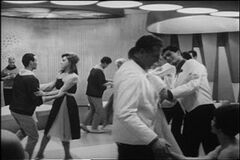
There was also Ikarie XB-1 (1963), a Czech film, and one of my favourites discoveries of the BFI season. It tells the story of a far-future expedition to the “White Planet” in orbit around Alpha Centauri. Beautifully shot in pin-sharp black and white it is instantly recognisable as a product of the 1960s, with funky costumes and some way-out dance routines but it is also a serious film with building tension, neatly defined characters and excellent writing. There’s also the obligatory dig at American militarism when the crew of the Ikarie discover a wrecked 20th Century spacecraft filled with dead capitalists – killed by their own greed – and sitting on a stock poorly stored and disturbingly easy-to-detonate nuclear weapons.
The propaganda in these films is often crude to the point of silliness – eliciting giggles from the audiences at the BFI screenings – but it is worth remembering the times in which they were made and that heavy-handed propaganda was not the province of Soviet cinema alone. Voyage to the End of the Universe, as Ikarie XB-1 was called on its release in America, recuts the original (removing much of the role for women) and replaces the final shot of an alien world with an image of the Statue of Liberty – welcoming the now alien space travellers to the “land of the free”. The Call of the Heavens was butchered by Roger Corman to remove any trace of the film’s internationalism or any criticism of America and released (with added vaginal monster) as Battle Beyond the Sun and much the same thing happened to The Silent Star (released in the West as First Spaceship on Venus) and Planet of Storms (under the name Voyage to the Prehistoric Planet) is very nearly unrecognisable in its American incarnation with scantily clad Venusian ladies lounging on a beach and dinosaurs cut in from an entirely different film. Most crucially, though, all remnants of the serious intent of Klushantev’s film are removed.
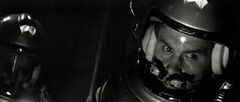
Soviet films of this era are notably different from their American contemporaries in a number of ways. Perhaps most obviously there tend to be more women on the screen who are expected to be more than just the love interest for the dashing hero (although they’re often that too) but the thematic differences are also striking. The default setting of American B movies of this era tends to be a barely suppressed terror of the enemy within and horror at the loss of individuality – obvious responses to the threat of communism. The Russian movies don’t display the same deep-seated psychological dysfunction. There aren’t monsters coming to shatter Soviet communities. American militarism and paranoia are frequently mocked – the Americans never get to win an argument – but they are never simply demonised either. Instead they tend to be treated with a pity that borders on condescension. The dropping of the atomic bombs in World War II is a recurring example of the greatest act of human cruelty and stupidity but, on the whole, the individual Americans who appear are shown to be victims of a system that is driven by greed and fear. The Soviet’s can afford to be magnanimous. They know America has already been left behind by superior Soviet know-how and scientific achievement and, in any case, the inevitable tide of history means that American capitalism is doomed to historical irrelevance. Again and again the rash, wrong-headed Americans have to be rescued from their own stupidity by the stoic, infinitely patient and good-hearted pioneers of the Soviet space programme or prevented from causing disaster through their propensity for violence by peace-loving and decent communists.
It’s hardly surprising that 1960s America wasn’t ready to swallow these films in the raw.
And yet, despite the crudeness of the Cold War polarisation that seeps through in regular doses, there is still something refreshing in a collection of films in which the heroes don’t instantly respond to encounters with the strange or the alien by resorting to violence or shuddering in repulsion and for whom contact with the unknown is an opportunity for discovery not the precursor to disaster. What remains memorable about this clutch of films is their openness and optimism. Their faith in both humanity and in the possibility of a better world may seem naïve now but only the most curmudgeonly of viewers would deny that the sentiments seem heartfelt and that the message is affecting. The peaceful, forward-looking, successful Soviets that these films predict only ever existed in the imagination of filmmakers, propagandists and a handful of optimistic intellectuals but the possibility of them remains seductively appealing. The moment when it seemed that the Soviet experiment really was outpacing the capitalist bloc and that the future belonged to the kindly, scientifically advanced and honest peoples of the Soviet Union was, it turned out, a collective hallucination, but that doesn’t mean that these glimpses of a world that might have been aren’t still appealing. As the product of an unfulfilled moment these films remain a heady, hopeful, draught.
However, as is often the case with powerfully mind-altering substances, the effects of binging on hope and optimism were short-lived and the hangover that followed wrought a terrible vengeance.
The Breshnev era did produce two familiar but still striking pieces of science-fictional cinematic genius – Tarkovsky’s Solaris (1970) and Stalker (1980). And, as part of the Kosmos, season the BFI presented two other films from this period of tightening control and spiralling decline that echo very precisely the themes of Tarkovsky’s masterpieces – Mark Piestrak’s Pilot Pirx’s Inquest (1979) and Luposhanksy’s A Visitor to the Museum (1989).
There could hardly be a more brutal contrast between this crop of Soviet sf and those that had gone before.
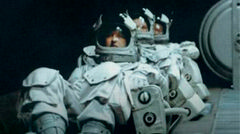
Solaris and Pilot Pirx’s Inquest, both adapted from the work of Stanislaw Lem, ask the same question: “What does it means to be human?” And both come to similar conclusions. Piestrak’s film may have the aesthetic appeal of an episode of The New Avengers or The Professionals but in plot and theme it can be seen as an effective prequel to Blade Runner. Pirx, the space hero with a reputation for honesty, is hired to take a ship on a routine mission to the rings of Saturn to report on the effectiveness of the crew – some of whom are experimental androids that the United Nations are seeking to evaluate as replacements for human crews. Pirx’s problem becomes both practical and philosophical. Someone is trying to stop him making his report. He survives a preposterously over-complicated assassination attempt (featuring a big remote control truck, a robot driver and a mountain road) but once the mission starts it quickly becomes apparent that there is a saboteur aboard his ship, The Goliath, and they are willing do anything to prevent Pirx’s return to Earth. At the same time, however, Pirx becomes obsessed with finding a way to discover who aboard his crew is a real human and who is a simulacrum. Tarkovsky’s Solaris approaches the same issue with greater flair and more emotional depth, but both stories come to the same conclusions: humanity is defined by our failures. Aboard The Goliath the deranged android is revealed and destroys itself when Pirx freezes in the face of overwhelming danger. The logical machine cannot grasp that Pirx’s inability to act might be the result of simple human failure. In Solaris the characters on the battered space station above the ineffably strange alien world are a broken lot, all of them are trapped and crushed by their pasts. They are all both horrified and fascinated by the things they’ve done – ashamed but unable to abandon what they have created. Even Hari, a creation of the vast cool mind that inhabits – or perhaps is – the churning ocean below, is unable to escape the burden of her human form and is dragged back into the desperate, recurring patterns of her template’s past failures. It is Hari’s tragedy that as she reclaims the memories that define her human existence she is also bound to inherit the damage that will lead to her second annihilation.
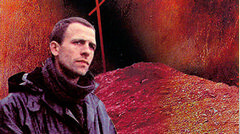
By the time of Stalker and A Visitor to the Museum the hopes of the Kruschev-era space operas have entirely evaporated. These are post-apocalyptic films in which men wander hopelessly through ravaged landscapes. The universe has ceased to be something that we reach towards in the hope of conquering. Indeed, even the prospect of understanding the world has passed beyond reach. Instead, nature has become our interrogator and we are the object of its forensic and unwavering gaze. Once the heroes of the Soviet Union looked into the mysterious universe for answers, now the universe looks into our souls and reveals our rotten cores. Events are inexplicable. Faith is beyond reach. The stalker can never achieve his desires, the tourist never reaches the museum, but both wander through blasted landscapes picking over the detritus of a shattered civilisation. Religious imagery features prominently in both films, as do passages from the bible. But there is no redemption or comfort to be found in this universe and, if there is a god in these films, it is an Old Testament bringer of trials, tribulation and terror.
Luposhansky – an acolyte of Tarkovsky and a director who has made a career of taking the great man’s themes and pushing them to the edge of madness – drives home (perhaps overdoes) the religious imagery in A Visitor to the Museum – including bizarre, terrifying, rituals and an excursion via Golgotha – but as the hordes of mutants bash their skulls against the wall and call out “Let us out of here! Let us out of here!” it’s not hard to see a reflection of the plight of the Soviet people as madness engulfs the final days of the USSR.

In the midst of this chaos – as old orders teeter on the edge of collapse and past hopes seem to mock the present – it is perhaps not surprising that Soviet sf should respond with a farce. Kin-Dza-Dza (1986) is a bewildering film in which two hapless Muscovites find themselves transported to a distant universe and the desert world of Pluke where they encounter a strange civilisation. They find themelves amongst a technologically advanced but socially repressed people who are ruled by lazy aristocrats and bound by ludicrously complex rules which divide the world into two castes – the privileged and their slaves (whose position are interchangeable depending on circumstances). Communication is made almost impossible because most conversations consist almost entirely of repetition of the word “Koo!” and matches are worth more than gold. Kin-Dza-Dza is both an absurd comedy and a deeply bitter film that makes few concessions to foreign audiences (I felt many of the references rushing straight over my head). Even so, its anger and frustration at the unfairness and stupidity of the world is impossible to miss. Perhaps the only tenable response to a world that is falling apart is to surrender to the insanity and to laugh at the absurdity.
There is a certain magnificence in these late Soviet sf films, but it is the magnificence of desolation. There is euphoria too, but it is the euphoria that comes when the final shred of hope is abandoned and we surrender to fate. These are films drenched in paranoia, torment, isolation and loss.
And, powerful though these films are in their own right, in the context of the Kruschev-era’s bursting forth of hope and imagination, it is what is missing from the films of the 1970s and 1980s that is most interesting and, in a way, most distressing. The spaceships disappear (along with the roles for women) and with them goes any faith in common humanity and any sense of collective endeavour or common purpose in which human ingenuity might triumph over adversity. In place of optimism and ambition come scatterings of lonely, confused and often unstable men, overwhelmed by their fate, at the mercy of nature and driven by forces they cannot control. The universe has become unknowable. Science and technology cease to be a path to truth or to a better world and become a trap, a threat to our survival.
These films retreat from any hope of understanding. We will never understand and therefore can never hope to communicate with or control the universe and the alien creatures it might contain. But it gets worse. For not only can we never hope to understand what is “out there” beyond the world we take for granted – we cannot even hope to understand our fellow humans or our own minds.
There is nothing to be done.
And then the Soviet Union was gone and there was only Russia. But cinema remained and cinema’s fascination with space continued, though now transformed. Once space adventures had fed Soviet dreams of glorious futures but now they were the subject of recollections of a moment that had been lost. The new mood is not nostalgic precisely, because awareness of the price paid for those moments of hope remains raw, but it is tinged with a sense of something that has been lost. The BFI’s Kosmos season offered three examples of modern Russian cinema that looked back upon the “glory days” of the space era.
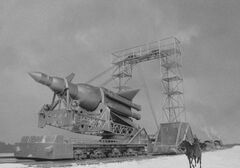
Perhaps the most straightforward is First on the Moon (2005), a fake documentary that purports to uncover a Stalin-era mission to the moon and the fate of those who contributed to it. The film highlights the casual cruelty of the Soviet regime, its paranoid secrecy and the pervasive surveillance of the population but as a film it is slight – failing to allow us to get close to any of the central characters or offering a human face to their suffering. It is hobbled by its pseudo-documentary form though there are chilling moments – such as the gassing of the neophyte cosmonauts – and there are places where it uses the surveillance footage to good effect
In Dreaming of Space (2005) and Paper Soldier (2008) the moments in which the Soviet space programme first leapt into the skies form the background to more personal stories that cast light on the price paid by ordinary Russians while their leaders were reaching for the stars.

In Dreaming of Space the dream is always about escape – whether it is into orbit or a doomed attempt to seek asylum in the West or finding a new love and a new life in Moscow. The events of Dreaming of Space are bookended by the launch of Sputnik and the return of Gagarin, in triumph, to Moscow. Horsey, an easy-going, likeable young cook, meets German, a mysterious figure who variously claims to be a spy and a cosmonaut in secret training. Set in an icy north Russian port (Murmansk?) director Uchitel’s effective use of a muted white and blue palette chills the blood throughout and against a background laced with reminders of Soviet-era repression – there’s an illicit transistor radio bringing Western music, the casually violent local militia stamping on “misbehaviour” and German’s doomed attempt at seeking asylum – Horsey loses and finds love and discovers a talent that offers him a route out of his current life. His journey involves a brush with a young pilot called Yuri and the appropriation of a famous piece of newsreel footage. Dreaming of Space is hard-headed about the failures of the Soviet era but there’s also an element of wistful desire for a moment that mixes up the vigour of youth with the discovery of space. It’s not an entirely satisfying film – the plot isn’t always coherent and the characters actions don’t always seem to have convincing motivations – but it does seem to neatly encompass the mixed feelings some Russians have about their recent history, a blend of pride and revulsion.
In Paper Soldier Daniel is a young medical officer working to prepare the first group of cosmonauts for their mission. The world-shaking events of Russia’s first manned spaceflights provide a backdrop for the young doctor’s personal dramas and for his growing unease at the ethics of the work he is doing. As the weeks count down to the first launch, Baikonur is revealed as a vast, bleak, mud-stuck wasteland where cattle and camels roam and where the feats of Yuri Gagarin and Gherman Titov remain firmly in the distant background. It could hardly be less like the magnificent, modernist star cities of the Kruschev-era imaginations.

Amidst all this, Daniel prevaricates hopelessly. He is married to Nina, also a doctor and every bit his equal, who lives in Moscow but he cannot resist Baikonur’s Vera who is, frankly, a bit of a doormat. But he is also unable to decide about anything else – the worth of his own work, the path he should take in the future, what the space race means for Russia and the world. There is a jagged criticism here of the Thaw Era intellectuals who enjoyed the freedoms of their time but did nothing to secure them for the long term and capitulated when Breshnev reasserted the state’s control.
At the heart of Paper Soldier, therefore, is a sense of impending doom. Even as Daniel dreams of space liners travelling to Jupiter the shattering desolation of the landscape and the coughing, spluttering incipient illness of all the characters tells the viewer that this is not a world where great dreams are fulfilled. And while the little circle of Daniel’s friends enjoy their sense of intellectual liberation they are plagued by doubts about their contribution to the world and the foundations upon which their freedom has been built. They are right to be concerned. Daniel has not long to live. Gagarin, will be dead by the time of the film’s coda. Their brief moment of (relative) freedom, achievement and aspiration will come to nothing. 1968 will sweep all this away and the shattered survivors, gathering again in 1971, don’t look back on the period as a missed opportunity so much as a moment of delusion – a time when they fooled themselves into believing that the impossible might have been made real. Paper Soldier is a stark film that doesn’t just regret the momentary hopes of the 1960s but that chastises those who were suckered into believing that the inevitable fate of the Soviet experiment could ever have been anything other than hardship, oppression and failure.
So, Kosmos presented almost a century of “Soviet” history through the lens of filmmakers who were, at least some of the time, looking up to the stars or out through the lens of the future. And all of it – at least through the filter of the choices made by those putting together the BFI’s season – seems to pivot around that one short decade when politics and science came together to create a flash of Technicolor (or whatever the Soviet equivalent was called) hope.
It all ended in tears, of course, but then almost everything does and the price that had to be paid, especially by the Russian people, was too high to ever justify.
And yet the dreams remain alluring.
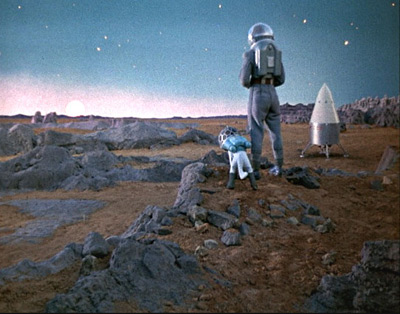
Who wouldn’t want to fly in one of Tsoilkovsky’s enormous, beautiful spaceships and visit the space stations built in Klusantev’s imagination? Who wouldn’t want to live in a better world that valued universal brotherhood, peace and cooperation? Who wouldn’t want to live in a world where there was someone patient and benevolent to rescue us from the mistakes made by Americans?
Okay, so it was all a dream. Okay, so, like Los in Aelita, perhaps dreaming has distracted us from the work that needs to be done here and now. But if we’re not dreaming, and if we’re not dreaming in Technicolor, then what’s the point of anything? If I have to define my humanity by my flaws, then I want those flaws to be too much ambition and too much hope, not fear and dread.
